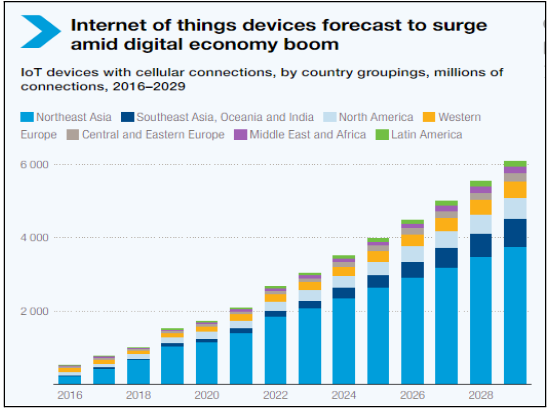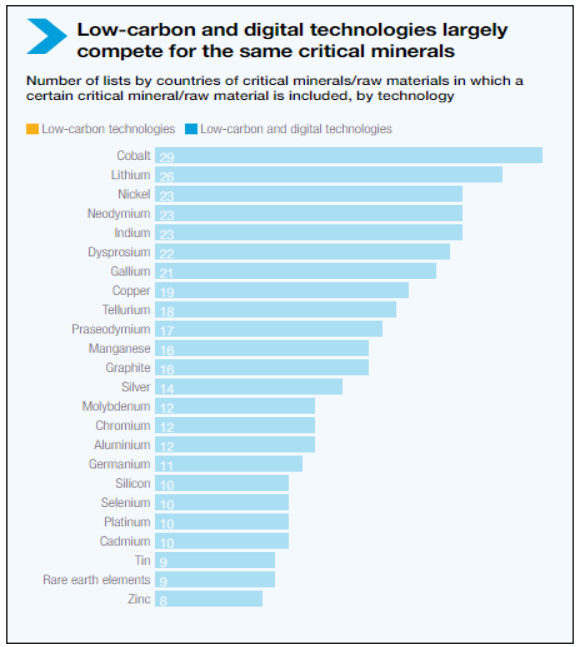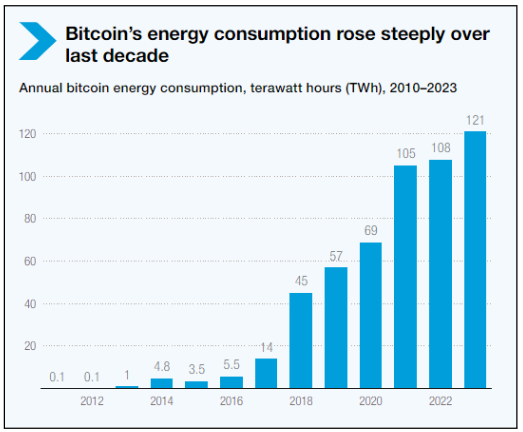GS Paper III
News Excerpt:
The Digital Economy Report 2024 highlights the critical need for environmentally sustainable and inclusive digitalization strategies.
More detail about news:
- Digital technology and infrastructure rely heavily on raw materials, and the increasing production and disposal of devices, along with rising water and energy demands, are significantly impacting the planet.
- For instance, the production and use of digital devices, data centers, and Information and Communications Technology (ICT) networks account for an estimated 6% to 12% of global electricity use.
Increasing Demand:
- Annual smartphone shipments have more than doubled since 2010, reaching 1.2 billion in 2023.
- New data from 43 countries, representing about three-quarters of global GDP, show business e-commerce sales grew nearly 60% from 2016 to 2022, reaching $27 trillion. This growth is putting an increasing strain on the environment.

Critical Minerals:
- As digital devices become more complex, they require a greater variety of mineral resources.
- In 1960, phones used 10 elements from the periodic table, which increased to 27 in 1990 and 63 in 2021. Consequently, the demand for critical minerals essential for both digital and low-carbon technologies is surging.
- According to the World Bank, the demand for cobalt, graphite, and lithium is expected to rise by 500% by 2050.
- Securing access to these critical minerals has become a strategic priority for many countries, intensifying global competition and increasing the risk of geopolitical challenges in a highly concentrated market.
- In 2022, the Democratic Republic of the Congo produced 68% of the world’s cobalt, Australia and Chile accounted for 77% of lithium production, and Gabon and South Africa produced 59% of manganese.
- China handles over half of the global processing for aluminum, cobalt, and lithium, and nearly 100% for natural graphite.
- The digital economy is resource-intensive. For example, a two-kilogram computer requires 800 kilograms of raw materials, and a smartphone's life cycle requires about 70 kilograms.
- For resource-rich developing countries, the rising demand for minerals presents economic opportunities. However, to fully capitalize on these opportunities, they must move up the value chains rather than merely supplying raw materials.

Energy Demand:
- From 2018 to 2022, electricity consumption of the 13 largest data center operators more than doubled.
- It is estimated that data centres worldwide will consume as much energy as France by 2022 – 460 terawatt-hours (TWh) of electricity.
- Their energy consumption is expected to double to 1,000 TWh by 2026, according to the International Energy Agency.
- Cryptocurrency technologies are also energy-intensive. For example, Bitcoin mining's global energy consumption rose 34 times between 2015 and 2023, reaching an estimated 121 TWh.

Water Demand:
- Digitalization’s water consumption is also growing, which is a concern in a world where two billion people still lack access to safe drinking water.
- In 2022, Google’s data centers and offices consumed more than 21 million cubic meters of water.
- Newer technologies, such as generative AI, also require more potable water for cooling servers.
Greenhouse Gas Emissions:
- The production phase of digital devices is the most impactful, generating around 80% of smartphone greenhouse gas (GHG) emissions.
- Environmental harm occurs throughout the lifecycle of devices and ICT infrastructure, including through e-commerce.
- In 2020, the ICT sector emitted an estimated 0.69 to 1.6 gigatons of CO2 equivalents, corresponding to 1.5% to 3.2% of global GHG emissions.

Developing Countries:
- Developing countries face the environmental costs of digitalization but receive fewer benefits.
- They export low-value raw materials and import high-value devices, along with increasing digital waste.
- Geopolitical tensions over critical minerals, which are abundant in many of these countries, add to the challenges.
- In 2022, the Democratic Republic of the Congo produced 68% of the world’s cobalt, Australia and Chile accounted for 77% of lithium production, and Gabon and South Africa produced 59% of manganese.
- China handles over half of global processing for aluminum, cobalt, and lithium, and nearly 100% for natural graphite.
- Developing countries generate less than 1 kilogram of digitalization related waste per person compared to 3.25 kilograms for developed countries. For the least developed countries, it’s just 0.21 kilograms.
- A significant portion of digital waste created in developed countries is sent to developing nations, where formal collection and recycling systems are often inadequate.
- In 2022, only 7.5% of digital waste in developing countries was formally collected, compared to 47% in developed countries.
Digital waste:
- Digital waste is growing faster than collection rates. Waste from screens and small IT equipment rose 30% between 2010 and 2022, reaching 10.5 million tons.
- Improper disposal leads to pollution and other health and environmental hazards.
- Increasing demand for data transmission, processing, and storage for technologies like blockchain, AI, 5G mobile networks, and IoT is boosting emissions.
Need for Circular Digital Economy:
- The report urges bold action from policymakers, industry leaders, and consumers, advocating for a global shift towards a circular digital economy.
- This shift would focus on durable products, responsible consumption, reuse and recycling, and sustainable business models.
Way Forward:
- Addressing these issues requires policy reforms, technological innovations, and action from all stakeholders – policymakers, businesses, and consumers – to make business models more circular, logistics more energy-efficient, packaging more sustainable, and consumption more responsible.
- It requires international cooperation, sustainable sourcing, and policies that balance the needs of all stakeholders to ensure a stable and ethical supply chain for critical minerals.
- To tackle the environmental challenges of digitalization, we must transition to a circular and inclusive digital economy.
- This involves adopting sustainable practices throughout the entire lifecycle of digitalization – from design and production to usage and disposal – while ensuring equitable economic benefits.
- A circular economy minimizes waste and maximizes resource use through reusing, refurbishing, recycling, and extending product lifespans.
- However, only 7.2% of the global economy is estimated to be circular, and this share is declining due to increased material extraction and use.
- Shifting to a circular and inclusive digital economy addresses environmental concerns while promoting economic opportunities and job creation. For example, the global market for electronics recycling is expected to grow from $37 billion in 2022 to an estimated $108 billion by 2030, led by the United States and China.
- The report calls for a shift away from the “extract-make-use-waste” approach. Besides more appropriate policies, key strategies include designing for durability and repairability, promoting recycling and recovery, encouraging responsible consumption, and supporting sustainable business models.


